Did you know that by 2020, one in two Americans over the age of 50 are expected to have or be at risk for developing osteoporosis? This, along with increasing numbers of active agers who are concerned about maintaining their health and wellness as they grow older, is driving the demand for health and exercise professionals who understand bone and joint safety protocols.
Exercise and physical activity are key to developing bone density because mechanical stress on the bone stimulates and strengthens it. Once osteoporosis is present, however, there is limited evidence that exercise alone can improve bone density. Yet, research does exist that suggests post-menopausal women can experience bone-mineral density improvements from high-intensity resistance and impact training.
Many active agers are, understandably, concerned about high-impact training, particularly if they already have developed osteoporosis or arthritis. How can you reassure those clients who may be afraid of high-intensity resistance training? And how should you address injury-prone subsets of this population?
First, you must start with a solid foundation of sound kinematics. A reliable bone health program should feature multicomponent training including balance, resistance, and spinal extensor strength and endurance. (Giangregorio et al., 2015; Sinaki et al., 2002). Additionally, integrating alignment-based exercises can help improve the absorption and transmission of forces through the skeleton for better osteogenic effects, while also reducing the possibility of injury when load and duration are increased.
Thoracic spinal flexion exercises, such as crunches, have been associated with increased risk of vertebral fractures and should generally be avoided in this population. There are, however, numerous other movements that can be incorporated that offer protective strengthening benefits.
What follows is a sampling of five movements that require little-to-no equipment to help prepare your clients for optimal bone loading from heavier loads and impact. These movements will also help improve function as well.
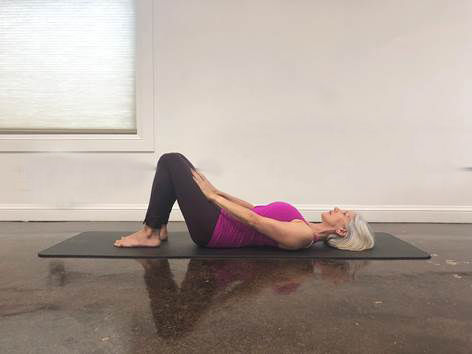
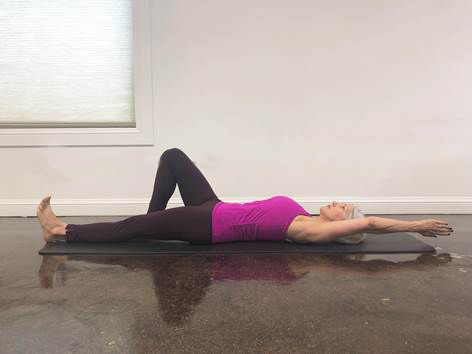
Supine Limb Reach
Decompress the spine.
- Lie supine with the feet planted.
- Slide one foot out and bring the same-side arm by the ear.
- Inhale and stretch the heel and hand in opposite directions.
- Exhale and relax.
- Repeat several times before switching sides.

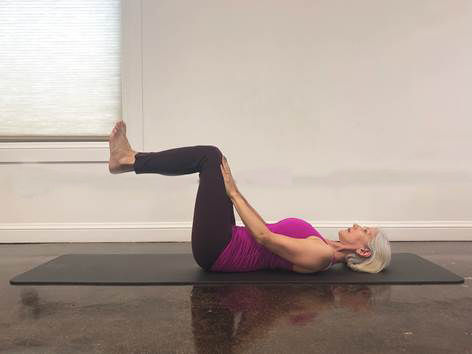
Ab Prep
Activate the deep lumbopelvic stabilizers that help with standing balance and postural control.
- Lie supine with the feet planted.
- Press the hands into the thighs while exhaling and engaging the deep core muscles (we call this the “zipup.”) Be sure the belly does not pop up.
- Inhale and release. Repeat six to eight times.
- To increase the intensity of this movement, lift the legs into a 90/90 position with the feet at the height of the knees and the shins parallel to the ceiling. Press the hands into the thighs when exhaling and posteriorly tilt the pelvis so the lumbar spine flattens. Again, draw the belly in toward the mat. Hold for several seconds before releasing and repeating.

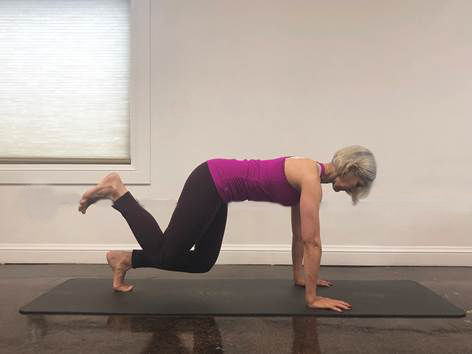
Knee Lifts
Tap into the connection between the shoulder, trunk and hips to build endurance for spine and shoulder alignment while strengthening the back, abs and thighs.
- Move into a quadruped position on the hands and knees with the toes tucked.
- Exhale and hover the knees and lift the belly without rounding the back. Extend the neck to avoid the “dangling head syndrome.”
- Lower the knees and inhale to repeat.
- To increase the intensity of this movement, lift a foot when lifting the knees or add a crawl forward and back.
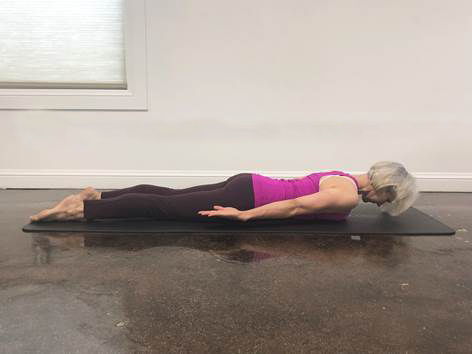
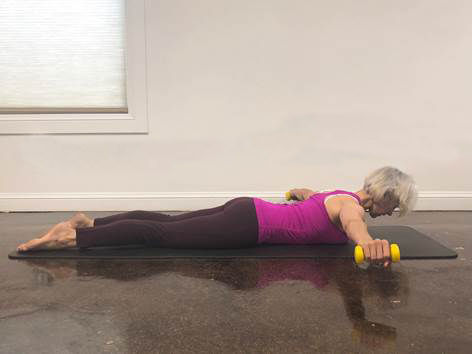
Back Extension
Work the back for targeted spine strengthening, better balance and improved alignment.
- Lie prone with the hands by the hips; the palms should face up. Gently press the pubic bone into the mat to lift the belly.
- Hover the head and arms while looking down. Keep the feet down and isolate the effort into the muscles surrounding the upper thoracic spine. Hold for several seconds and repeat. Focus on reaching through the crown of head.
- To increase the intensity of this movement, add 2- to 3-lb weights in each hand without compromising form. Or, circle the arms to the sides and to the ears without the shoulders shrugging.
Squats
Strengthen the hips, improve mobility and function, and load the skeleton in a weight-bearing orientation.
- Stand with feet a little more than hip-width apart in slight external rotation. Hold 2- to 3-lb weights in each hand.
- Sit back while hinging at the hips and reaching the arms forward; return to the starting position. Keep the knees over the toes during the squat, the shoulders relaxed and the gaze forward. Repeat eight to 10 times.
- To increase the intensity of this movement, hold the squat and shift the weight to one leg when rising, alternating sides. Or, put the weights aside and add a punch forward with alternating arms while holding the squat.
Want more of these movements and to dive deeper into an exercise system for bone and joint health? Check out the Buff Bones® Instructor Training online course today!
References
Giangregorio, L.M., McGill, S. and Wark, J.D. (2015). Too fit to fracture: Outcomes of a Delphi consensus process on physical activity and exercise recommendations for adults with osteoporosis with or without vertebral fractures. Osteoporosis International, 26, 3, 891–910.
Sinaki, M., Itoi, E. and Wahner, H.W. (2002). Stronger back muscles reduce the incidence of vertebral fractures: A prospective 10-year follow-up of postmenopausal women. Bone, 30, 6, 836–841.




 by
by 




 by
by